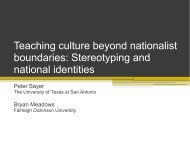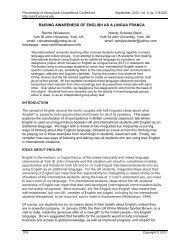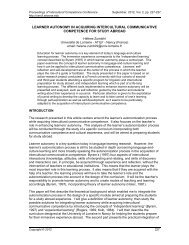BYRAM VERSUS BENNETT: DISCREPANCIES IN THE ... - CERCLL
BYRAM VERSUS BENNETT: DISCREPANCIES IN THE ... - CERCLL
BYRAM VERSUS BENNETT: DISCREPANCIES IN THE ... - CERCLL
Create successful ePaper yourself
Turn your PDF publications into a flip-book with our unique Google optimized e-Paper software.
Paula Garrett-Rucks Byram Versus Bennett<br />
skills in Discussion 3, on family structure, she explicitly wrote that her opinion of the French had<br />
changed on her final questionnaire as follows.<br />
The only negative image I have of French people is that they rarely smile. However, I<br />
don’t think of them as rude or strict people anymore. I realize that I grew up thinking<br />
smiling at a person was a polite thing to do. They just grew up thinking the opposite way<br />
(that it was overbearing or flirtatious) (Lauren, Final questionnaire).<br />
Each of these three participants’ had a shift in worldviews occur in the second phase of a<br />
discussion, after personally relating to a French informant’s perspective toward differing cultural<br />
practices. Further evidence existed in the data to suggest that these three learners continued to<br />
display evidence of IC after the threshold moment of displaying fully developed intercultural<br />
attitudes, knowledge and skills. On the contrary, there were continual fluctuation between<br />
ethnocentric and ethnorelative thinking found when situating the transcripts of the discussions<br />
within Bennett’s DMIS.<br />
Evidence to question the linear nature of development proposed in Bennett’s DMIS<br />
In an attempt to capture the influences of the pedagogical interventions—explicit cultural<br />
instruction and authentic texts during Phase 1 and French informant interviews during Phase<br />
2—I compared the percentage of postings where participants’ worldviews were evaluated at<br />
ethnocentric levels (Stages 1-3) to ethnorelative levels (Stages 4-6) for each phase of the<br />
discussion in. Based on this criteria, I detected shifts in learners’ ethnocentric to ethnorelative<br />
worldviews toward French smiling practices in Discussion 1 and French educational practices in<br />
Discussion 2 after exposure to the French informants’ perspectives in Phase 2 of these<br />
discussions. However, Discussion 3 was different. The information in Phase 1 of Discussion 3<br />
described the French PACs—a form of civil marriage originally intended to support homosexual<br />
unions—as an increasingly accepted cultural practice among heterosexual and homosexual<br />
partners. However, the four French informants expressed a personal preference for traditional<br />
marriages in their own lives, and inadvertently discredited the status of PACs stating things like,<br />
“the PACs is an arrangement for convenience, like for tax breaks, not love” (Florence). Many<br />
participants in the discussion appeared disappointed by the French informants’ apparent lack of<br />
acceptance of the PACS stating things like, “the abuse of the PACS reminds me of the abuse of<br />
the welfare system here” (participant, week 5). Consequently, there was a shift from<br />
ethnorelative to ethnocentric thinking in Discussion 3 in Phase 2 of the discussion (see Figure<br />
1).<br />
<strong>CERCLL</strong> ICC Proceedings 21





